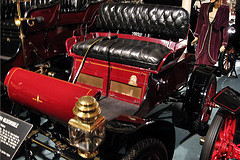You could say that the car was as cute as a bug’s ear, but its bug-eyes gave it the indelible icon that has stayed with us for nearly 50 years. ![]() The Austin-Healey Sprite wasn’t the first car that Donald Mitchell Healey built, nor was it the best, but, due to its appealingly affordable price and its so-cute-you-want-to-cuddle-it visage, the Sprite is the Healey car that has the most universal charm.
The Austin-Healey Sprite wasn’t the first car that Donald Mitchell Healey built, nor was it the best, but, due to its appealingly affordable price and its so-cute-you-want-to-cuddle-it visage, the Sprite is the Healey car that has the most universal charm.
Indifferent spirit
Healey’s saga was already moving into its third act when the Sprite was presented in 1958. DMH, as he liked to be called, was born in 1898 in Perranporth, Cornwall, the son of a shopkeeper who finally became a land developer. Like Herbert Austin and Henry Royce before him, the young Healey became enamored of tools, machinery and the most infant industry of the day, aviation. He left school to join Sopwith and within months, the outbreak of World War I encouraged Healey to enlist in the Royal Flying Corps. Immediately, he shifted from mechanic to aviator, but his short flying career ended when he crashed in 1916. Mustered out of the service soon after, he returned home to Cornwall where he involved himself in two other fledgling industries: automobiles and radios. Read more . . .
 While Henry Ford and Ransom E. Olds set out to make cars for the “common man,” the Packard brothers, James Ward and William Doud, decided they would sell cars to men of uncommon richness. Their plan made sense because, before they had even built their first motorcar, the Packards themselves were gentlemen of substance.
While Henry Ford and Ransom E. Olds set out to make cars for the “common man,” the Packard brothers, James Ward and William Doud, decided they would sell cars to men of uncommon richness. Their plan made sense because, before they had even built their first motorcar, the Packards themselves were gentlemen of substance.
 While their American cousins quickly produced automobiles in mass manufacture, starting with Ransom E. Olds before the turn of the last century, the British seemed perfectly satisfied to approach car building as a cottage industry. Hammer out a few here, put together a few there, and perhaps build a little bit of earnings into the enterprise. This was the ourlin for many British car builders, from Morgan to Jaguar to MG to Triumph to Aston Martin.
While their American cousins quickly produced automobiles in mass manufacture, starting with Ransom E. Olds before the turn of the last century, the British seemed perfectly satisfied to approach car building as a cottage industry. Hammer out a few here, put together a few there, and perhaps build a little bit of earnings into the enterprise. This was the ourlin for many British car builders, from Morgan to Jaguar to MG to Triumph to Aston Martin. Cord, Ruxton and Gardner all proposed production front-wheel-drive automobiles several years before Citroen joined the party. The importance of Citroen’s involvement is not that it was first with front-wheel-drive, but that it was the first company to make front-wheel-drive a true success. Unfortunately, that victory came almost simultaneously with Andre Citroen’s death, so the legendary French auto magnate never got to enjoy the fruits of his gamble.
Cord, Ruxton and Gardner all proposed production front-wheel-drive automobiles several years before Citroen joined the party. The importance of Citroen’s involvement is not that it was first with front-wheel-drive, but that it was the first company to make front-wheel-drive a true success. Unfortunately, that victory came almost simultaneously with Andre Citroen’s death, so the legendary French auto magnate never got to enjoy the fruits of his gamble.